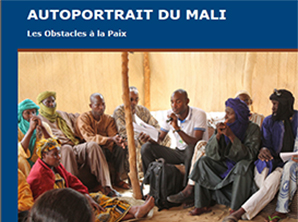Report on obstacles to peace in Mali out now

Veuillez trouver ci-dessous la version française
Today, the Institut Malien de Recherche Action pour la Paix (IMRAP), in partnership with Interpeace, launched the report and documentary film titled “Self-portrait on obstacles to peace in Mali”. These contain the results of participatory consultations of over 4,700 Malians across the eight regions of Mali and in two refugee camps.
This Self-portrait of Mali is the first step in a process to build trust and consolidate peace, and which established a consensus and shared vision on what the real obstacles to peace in Mali are. It is on the basis of this common understanding that Malian society can collectively begin to research and implement sustainable solutions to its challenges to peace.
For more information on this report and its significance, we encourage you to consult the fact sheet.
The full report can be found here, and the documentary film (French) is available at the following link.
The executive summary of the report is also accessible.
Aujourd’hui, l’Institut Malien de Recherche Action pour la Paix (IMRAP), en partenariat avec Interpeace, a publié le rapport et le film documentaire intitulés « Autoportrait du Mali, Les obstacles à la paix. » Le rapport et le film regroupent les résultats d’une recherche participative conduite auprès de 4700 Maliens dans les huit régions du Mali et dans deux camps de réfugiés.
Cet Autoportrait du Mali est le premier jalon d’un processus de renforcement de la confiance et, plus largement, de la consolidation de la paix. Il a également établi une vision sur les véritables obstacles à la paix au Mali de manière consensuelle. C’est sur la base de cette compréhension commune de ces obstacles que la société malienne pourra entamer collectivement la recherche et la mise en œuvre de solutions durables à ces défis.
Pour plus d’information sur ce rapport et les enjeux qu’il représente, veuillez consulter la Fiche d’information.
L’intégralité du rapport est disponible ici, et le film documentaire peut être visionné à l’adresse suivante.
